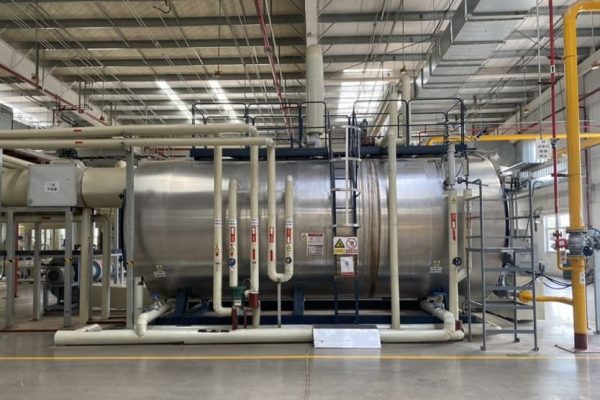Replacing an industrial steam boiler is a major capital decision for any plant owner. Understanding the industrial steam boiler replacement cost — including typical ranges and hidden costs — and the factors that drive it helps you make a financially sound choice, limit downtime, and prioritize long-term energy savings.
How Much Does Industrial Steam Boiler Replacement Cost — Typical Price Ranges
The industrial steam boiler replacement cost varies widely depending on capacity, pressure rating, fuel type, emissions controls, and site work. Small, low-pressure packaged units may start in the low tens of thousands of USD, while medium and large high-pressure systems commonly reach into the tens or hundreds of thousands once fully installed. Complex projects that include economizers, feedwater systems, upgraded controls, structural work, and emissions equipment can push total installed cost higher.
When budgeting for a replacement, include equipment price, freight and rigging, foundations or structural reinforcement, near-boiler piping and valves, feedwater treatment systems, controls and instrumentation, electrical and HVAC work, permits and inspection fees, removal and disposal of the old unit, and commissioning labor. Installation, piping, and controls add a significant percentage to the equipment-only price, so estimate total installed cost rather than equipment-only price.
Repair or Replace — Which Is Cheaper?
Deciding whether to repair or replace comes down to age, failure mode, and lifecycle costs. A common field heuristic is the “50% rule”: if a major repair approaches half the price of a new, comparable unit, replacement is often the better long-term investment. Compare repair estimates against the projected industrial boiler replacement cost or cost to replace industrial steam boiler and run a lifecycle analysis.
Other factors: parts availability, safety and emissions compliance, and rising fuel use. If spare parts are obsolete or the boiler no longer meets regulations, the cost of replacing an industrial steam boiler may be justified by lower fuel bills, reduced maintenance and improved uptime.
Do I Need to Replace My Boiler?
Plan replacement if you see repeated failures, escalating repairs, thinning or corroded pressure parts, declining steam output or uneven steam quality, or control systems that cannot meet modern automation or emissions standards. If several issues exist, start planning and set aside budget for the industrial steam boiler replacement cost. A professional condition survey (including NDT of pressure parts) and an energy audit will provide a defensible timeline.
Industrial Steam Boiler Lifespan
With proper water treatment and maintenance, industrial steam boilers often last about 20–30 years. Heavy cycling, poor water quality or insufficient maintenance will shorten life. When estimating remaining service life, factor in age, maintenance history, and operating severity to decide the proper investment horizon and expected cost of replacing an industrial steam boiler. Also, understanding the industrial steam boiler replacement cost over that horizon is critical to budget planning.
Most Efficient Boilers — How They Affect Industrial Steam Boiler Replacement Cost
For fuel-fired steam production, condensing boilers, economizers and heat-recovery systems deliver the best thermal performance by reclaiming sensible and latent heat from flue gases. These features reduce operating costs and improve payback on a replacement. Electric steam boilers are nearly lossless at point of use but require evaluation of local electricity prices and grid carbon intensity.
Evaluate whole-system performance — insulation, steam traps, distribution losses and control strategy — to understand how changes affect savings and the industrial steam boiler replacement cost.
Installation Timeline
Installation time ranges with complexity. A like-for-like swap in an accessible boiler room may take a few days to a few weeks. Full turnkey projects that include a new boiler room, piping, control upgrades or structural work commonly take several weeks or more. Large, high-pressure installations typically require phased commissioning and extended testing, which lengthens the schedule. In your project plan, build in contingency and consider temporary rental boilers to reduce production risk — all of which affect industrial steam boiler replacement cost.
Minimizing Downtime and Budget Surprises
To avoid surprises, obtain multiple quotes with detailed line items (equipment vs installation vs contingency), verify permit lead times and local inspection windows, and include a modest contingency (10–20%). Temporary rental boilers, staged commissioning or parallel systems reduce downtime but add cost; include those options when you calculate the replace industrial steam boiler cost and related contingency.
Conclusion
Estimating industrial steam boiler replacement cost requires more than the equipment sticker price. Use a lifecycle approach that includes installation, downtime, permits and expected energy savings. When fuel savings, reliability improvements and regulatory compliance justify the upgrade, investing in a high-efficiency or heat-recovery-equipped boiler often reduces total cost of ownership and produces measurable ROI. Accurately forecasting industrial steam boiler replacement cost helps secure funding and reduce surprises.
FAQ
Q: What budget should I expect?
A: Small industrial units may start in the low tens of thousands USD; medium and large industrial boilers commonly range into the tens or hundreds of thousands once installed. Remember to include installation and site work in your budget when estimating the industrial steam boiler replacement cost. The cost to replace industrial steam boiler can vary widely by scope.
Q: When is replacement more economical than repair?
A: If a major repair approaches roughly fifty percent of a new unit’s price, replacement usually gives better long-term value.
Q: How long do industrial boilers last?
A: About 20–30 years with good maintenance.
Q: Which boiler type is most efficient?
A: Condensing boilers with economizers and heat recovery are typically the most efficient for fuel-fired systems; electric boilers can be efficient at point of use depending on electricity cost.
Q: How long does installation take?
A: From a few days for straightforward swaps to multiple weeks for turnkey and high-pressure installs.
Get your best price
Quickly compare 3 FREE quotes
- Engineer quick quote
- The overall delivery speed is fast
- Financial choice
- Low installation costs and cost savings
25 years+ of boiler R&D
More than 20 innovative technologies



